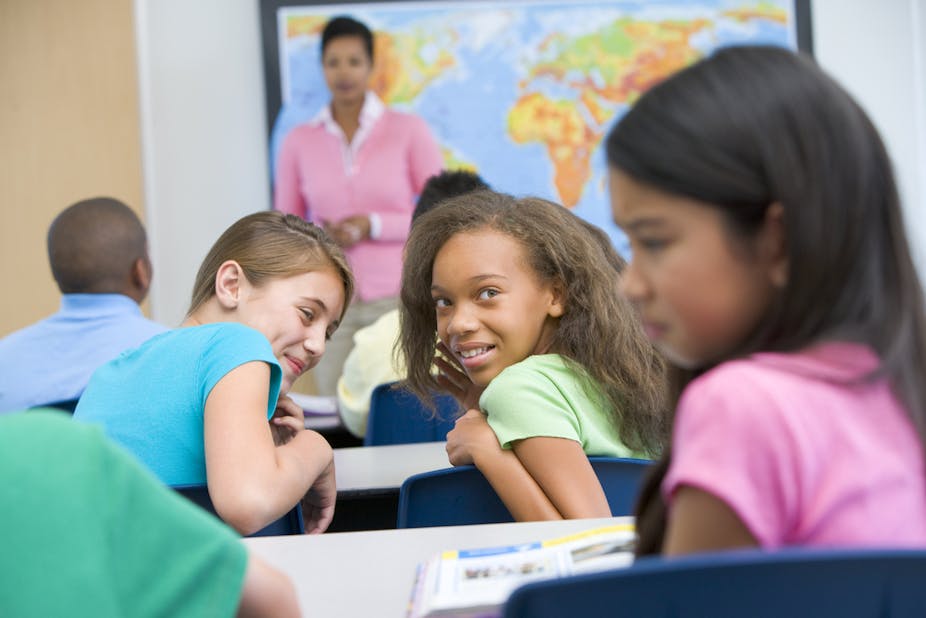School bullying is a proactive form of aggression which doesn’t only have impacts on the individuals being targeted, but also on the child who is bullying, their classmates, the climate and tone of the class, the teacher, the parents and families, and the broader school community.
Gone are the days when bullying was an issue left up to the victim alone to deal with. Most schools now have whole-school anti-bullying policies, which ensure that everyone recognises that they have a role to play as part of the solution.
The difficulty for teachers is that what actually occurs between students is not often visible to them. Bullying can occur online or via mobile phones out of school hours, or sometimes in parts of the school where no teachers are present.
How can teachers help to prevent bullying?
Creating a climate where young people feel safe in reporting to teachers or a trusted adult that one of their peers is being victimised is important, in order to counter the views that young people currently hold, that:
a) the teacher will do little to effectively stop it
b) that the bullying will get worse if they report it or
c) that they will become the next target.
The single most important thing any teacher can do to prevent bullying is to be proactive at the class and individual level. They should not assume that if they can’t see anything, then bullying isn’t happening.
Sometimes, however, teachers themselves can inadvertently contribute to the problem when they appear to do nothing, or seemingly ignore it. Teachers may be working behind the scenes to find a solution and to gather information, so it is important for them to communicate openly to parents and students the processes and timelines they are working through.
It is also important for the teacher to lead by example in modelling relationship skills. This applies not only to students, but to other staff and everyone in the school community. Children need to see what relationships based on mutual respect look like.
Teaching students about what is culturally and socially acceptable behaviour, and calling them out when their language or behaviour in the classroom isn’t appropriate, is fundamental to developing a safe and supportive class climate. Low-level vocabulary/excuses designed to trivialise bullying such as, “we were only having fun …” and “I was just …” should not be acceptable in a supportive class environment.
If any intimidating or bullying behaviour is perceived in the classroom it is important this is stopped as early as possible. During school hours teachers are responsible for the well-being of children in their care, and this includes intervening when bullying is occurring.
Teachers should be monitoring the social dynamic to identify how children and young people are interacting and engaging with each other. Paying attention to those who are isolated or vulnerable in some way is an important aspect of monitoring the class climate.
Students surrounded by friends and peers who will support them are less likely to fall victim to bullying. Building a cohesive group in the class and moulding the school environment to make sure all students have the opportunity to forge friendships and are not isolated from others are important strategies in preventing bullying.
Relationship and friendship problems are common throughout school and can often be the cause of bullying. Teachers should help resolve these social relationship issues before they escalate, by engaging children and young people in learning how to manage conflict.
It’s very important in these situations to involve the students in creating their own solutions so they feel ownership of their problems and resolutions. This ensures that the strategies are also appropriate for the child’s age and cultural context.
This means adopting a class philosophy of there being “no bystanders” in the class: where bullying is everyone’s problem and everyone is part of the solution; of not laying blame, but of enabling the individuals concerned to independently, and with the teachers’ support, manage any conflict, find solutions and determine ways of co-existing; and of promoting awareness and sharing concern for others, through an approach that supports the child who bullies and the child who is targeted.
In Australia, the National Safe Schools Framework provides guidelines for safe and supportive school communities, and the Safe Schools Hub provides practical examples and resources for teachers, schools, parents and students. Cybersmart offers information and outreach support to schools and families in relation to cyberbullying.
Teacher-student relationships are fundamentally important, and teachers have a pivotal role to play in countering bullying and cyberbullying in our schools. Keeping young people engaged and connected with authentic learning and creating inclusive classrooms where difference is celebrated breeds tolerance and acceptance.
At the end of the day, all any student who is targeted, and their parent, wants is for the bullying to stop. This can’t be done by ignoring it.
This is part of a Conversation series called “Bullying in schools”. Read the other pieces here.

